by Julie Schauer | Apr 9, 2013 | 19th Century Art, Berthe Morisot, Camille Pissarro, Drawings, Durer, Exhibition Reviews, Jean-Francois Millet, National Gallery of Art Washington, Pastels, Portraiture, Renaissance Art, Watercolor
 |
Albrecht Dürer, The Head of Christ, 1506
brush and gray ink, gray wash, heightened with white on blue paper
overall: 27.3 x 21 cm (10 3/4 x 8 1/4 in.) overall (framed): 50 63.8 4.1 cm (19 11/16 25 1/8 1 5/8 in.)
Albertina, Vienna |
The National Gallery of Art is hosting the largest show of Albrecht Dürer drawings, prints and watercolors ever seen in North America, combining its own collection with that of the Albertina in Vienna, Austria. Across the street in the museum’s west wing is the another exhibition of works on paper, Color, Line and Light: French Drawings Watercolors and Pastels from Delacroix to Signac. The French drawings are spectacular, but it’s hard to imagine the 19th century masters without the earlier genius out of Germany, Dürer, who approached drawing with scientist’s curiosity for understanding nature.
 |
Albrecht Dürer, Self-Portrait at Thirteen, 1484
silverpoint on prepared paper, 27.3 19.5 cm
(10 3/4 7 11/16 in.) (framed): 51.7 43.1 4.5 cm (20 3/8 16 15/16 1 3/4 in.)
Albertina, Vienna |
Dürer’s famous engravings are on view, including Adam and Eve, but with the added pleasure of seeing preparatory drawings and first trial proofs of the prints. Some of his most famous works such as the Great Piece of Turf and Praying Hands, are there also. In both exhibitions, as always, I’m drawn to the beauty and color of landscape art, especially prominent in the 19th century exhibition. However, both shows have phenomenal portraits to give us a glimpse into people of all ages with profound insights.
Dürer drew his own face while looking in the mirror at age 13, in 1484. He still had puffy cheeks and a baby face, but was certainly a prodigy. Like his father, he was trained in the goldsmith’s guild which gave him facility at describing the tiniest details with a very firm point. Seeing his picture next to the senior Dürer’s self-portrait, there’s no doubt his father was extremely gifted, too.
 |
Albrecht Dürer, “Mein Agnes”, 1494
pen and black ink, 15.7 x 9.8 cm (6 1/8 x 3 7/8 in.)
(framed): 44.3 x 37.9 x 4.2 cm (17 3/8 x 14 7/8 x 1 5/8 in.)
Albertina, Vienna |
In his native Nuremburg, the younger Dürer was recognized at an early age and his reputation spread, particularly as the world of printing was spreading throughout the German territories, France and Italy. We can trace his development as he went to Italy in 1494-96, and then again in 1500, meeting with North Italian artists Andrea Mantegna and Giovanni Bellini and exchanging artistic ideas. Dürer is credited with bridging the gap between the Northern and Italian Renaissance. I personally find all his drawings and prints more satisfying then his oil paintings, because at heart he was first and foremost a draftsman.
Though we normally think of Dürer as a controlled draftsman, there are some very fresh, loose drawings. An image he did of his wife, Agnes, in 1494, shows a wonderful freedom of expression, and affection. He married Agnes Fry in 1494 and did drawings of her which became studies for later works. She was the model for St. Ann in a late painting of 1516 and the preparatory drawing with its amazing chiaroscuro is in the exhibition.
 |
Albrecht Dürer, Agnes Dürer as Saint Ann, 1519
brush and gray, black, and white ink on grayish prepared paper; black background applied at a later date (?)
overall: 39.5 x 29.2 cm (15 1/2 x 11 1/2 in.) overall (framed): 64 x 53.4 x 4.4 cm (25 1/4 x 21 x 1 3/4 in.)
Albertina, Vienna |
|
Also on view are Durer’s investigations into human proportion, landscapes and drawings he did of diverse subjects from which he later used in his iconic engravings. We can trace how the drawings inspired his visual imagery. There are also several preparatory drawings of old men who were used as the models for apostles in a painted altarpiece.
 |
Albrecht Dürer, An Elderly Man of Ninety-Three Years, 1521
brush and black and gray ink, heightened with white, on gray-violet prepared paper
overall: 41.5 28.2 cm (16 5/16 11 1/8 in.) overall (framed): 63.6 49.7 4.6 cm (25 1/16 19 9/16 1 13/16 in.)
Albertina, Vienna |
My favorite drawing of old age, however, is a study of an old man at age 93 who was alert and in good health (amazing as the life expectancy in 1500 was not what is today.) He appears very thoughtful, pensive and wise. The softness of his beard is incredible. The drawing is in silverpoint on blue gray paper which makes the figure appear very three-dimensional. To add force to the light and shadows, Durer added white to highlight, making the man so lifelike and realistic.
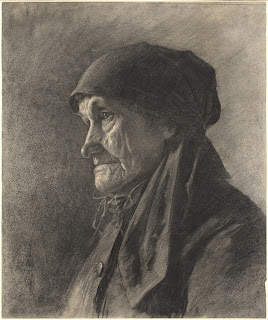 |
Léon Augustin Lhermitte, An Elderly Peasant Woman, c. 1878
charcoal, overall: 47.5 x 39.6 cm (18 11/16 x 15 9/16 in.)
National Gallery of Art, Washington, Gift of Mr. and Mrs. James T. Dyke, 1996 |
In the other exhibition, there’s a comparable drawing by Leon Lhermitte of an old woman in Color, Line and Light. Lhermitte was French painter of the Realist school. He is not widely recognized today, but there were so many extraordinary artists in the mid-19th century. What I find especially moving about the painters of this time is more than their understanding of light and color. I like their approach to treating humble people, often the peasants, with extraordinary dignity. Lhermitte’s woman of age has lived a hard and rugged life and he crinkled skin signifies her amazing endurance. We see the beauty of her humanity and the artist’s reverence for every crevice in her weather-beaten skin.
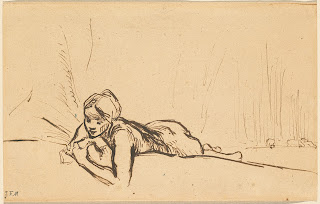 |
Jean-François Millet
Nude Reclining in a Landscape, 1844/1845
pen and brown ink, 16.5 x 25.6 cm (6 1/2 x 10 1/16 in.)
Dyke Collection |
|
There are many portraits of youth in the French exhibition, too, including fresh pen and inks such as Edouard Manet’s Boy with a Dog and Francois Millet’s Nude Reclining in Landscape, who really does not look nude.
Camille Pissarro’s The Pumpkin Seller is a charcoal without a lot of detail. She has broad features, plain clothes and a bandana around the head. She’s a simpleton, drawn and characterized with a minimum of lines but Pissarro sees her a substantial girl of character. The drawing reminds me of Pissarro himself. He may not be as well-known and appreciated as Monet, Renoir, Degas, yet he was the diehard artist. He was the one who never gave up, who encouraged all his colleagues and was quite willing to endure poverty and deprivation for the goals of his art. Berthe Morisot‘s watercolor of Julie Manet in a Canopied Cradle has a minimum of detail but is a quick expression of her daughter’s infancy.
 |
Camille Pissarro, The Pumpkin Seller, c.1888
charcoal, overall: 64.5 x 47.8 cm (25 3/8 x 18 13/16 in.)
Dyke Collection |
Taking in all the portraits of both exhibitions, I’m left with thoughts of awe for beauty of both nature and humanity. The friends I was with actually preferred the French exhibition to the Dürer. There were surprising revelations of skill by little known artists like Paul Huet, Francois-Auguste Ravier and Charles Angrand. The landscapes by artists of the Barbizon School and the Neo-Impressionists, are important and beautiful, but perhaps not recognized as much as they should be. In both exhibitions, we must admire how works on paper form the blueprint for larger ideas explored in oil paintings.
 |
Berthe Morisot, Julie Manet in a Canopied Cradle, 1879
watercolor and gouache, 18 x 18 cm (7 1/16 x 7 1/16 in.)
Dyke Collection |
It was a curator a the Albertina who wisely connected a mysterious Martin Schongauer drawing of the 1470s owned by the Getty to a Durer Altarpiece. The Albertina is a museum in Vienna known for works on paper, much its collection descended from the Holy Roman Emperors, one of whom Dürer worked for late in his career. The French drawings come from a collection of Helen Porter and James T Dyke and some of it have been gifted to the National Gallery. They’re on view until May 26, 2013 and Albrecht Dürer: Master Drawings, Prints and Watercolors from the Albertina will stay on view until June 9, 2013.
Copyright Julie Schauer 2010-2016
by Julie Schauer | Jan 14, 2013 | 19th Century Art, Berthe Morisot, Impressionism and Post-Impressionism, Manet, Metropolitan Museum of Art, Musee d'Orsay, Portraiture, The Art Institute of Chicago, Women Artists
 |
Manet, The Repose, 1870, Rhode Island School of Design. Berthe Morisot is at rest,
but the seascape behind her could symbolize an inner restlessness behind
her calm demeanor. |
Why hasn’t the love story of painters Édouard Manet and Berthe Morisot been told in film? (Both Manet and Morisot are represented in large numbers at the exhibition, Impressionism, Fashion and Modernity, formerly at Musée d’Orsay, but now at the Metropolitan Museum of Art in NYC and onto the Art Institute of Chicago this summer. Morisot was the subject of a large retrospective at Musée Marmottan Monet, Paris, last year, and her work, like much Impressionism, is so much better when viewed in real life rather than reproduction.)
Manet, a “people person” and painter of people, is the one artist of the past I would wish to meet above all others. Morisot, one of his muses, is the artist with whom I empathize more than any other. She loved in a painful way, but her only consolation was to marry his brother.
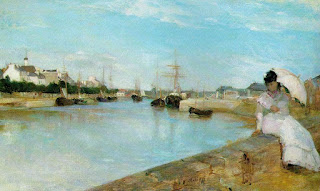 |
| Berthe Morisot, The Harbor at Lorient, 1869, National Gallery of Art, Washington |
Manet’s portraits of her are compelling. Manet , a man of paradox, painted realistic themes in an audacious style which was shocking to the mid-19th century. Yet he was conventional, proper, well-dressed and conservative in so many ways. His political ideas were forward-looking, but he was patriotic and enlisted in the National Guard during the Prussians’ siege of Paris in 1870. Deeply hurt by art criticism, Manet’s honor was also so important to him that he challenged an art critic to a duel by sword. Duels were remnants of the medieval era, very rare in 19th in 19th century France. The charismatic artist was the ultimate elegant Parisian, the first modern painter but deeply rooted in the past.
 |
Portrait of Édouard Manet, by Henri Fantin-Latour, 1867, Art Institute of Chicago
Fantin-Latour introduced Manet and Morisot, an important personal
and artistic relationship. |
Last week I watched a movie about Modigliani, but the story of Manet and Morisot’s love is far more interesting. Although letters exist, they don’t tell the whole story and mystery remains. An actress with the soulful eyes and depth of Juliette Binoche would be an ideal choice to play Berthe, although there are younger stars like Audrey Tautou who could do justice to her character. I can think of many actors who could be the confidant, dapper Manet. With the right script and right director, this story in film could be even more interesting than films of artists like Jackson Pollock, Vincent Van Gogh or Frida Kahlo, artists known for their tempestuous lives.
 |
Manet, The Balcony, 1868, in the Salon of 1869,
now in Musée d’Orsay, Paris |
While waiting for this film to be made, we can track the story and trace much of the love and feeling in Manet’s 12 portraits of Berthe. She was his leading muse, as he painted her more times than anyone else. Many of Manet’s people are distinctive for their air of nonchalance, and they end up revealing themselves if only by expressing a desire not to let us get to know them. Berthe was different, as he tapped into her soul and seemed to know the longing and wistfulness that was inside. These portraits are tantalizing and mysterious, and they come in many forms, but leave us guessing the extent of their relationship. Manet’s The Repose, at the top of this page, shows Berthe relaxed and dreaming on a sofa, but the image of a Japanese sea storm above her suggest turmoil may lurk beneath her quiet demeanor.
Manet first painted Berthe Morisot in The Balcony, but with two figures not in communication with each other or with the viewer. Berthe’s black eyes grab all the attention. Hers is the only face which is revealing, while the others have expressive hand gestures. The second woman who posed for Manet, violinist Fanny Claus, appears vapid and vacant next to the pensive Berthe leaning on a green balcony. The man, painter Antoine Guillemet, enters from behind and a boy is vaguely seen in the black background. The womens’ white dresses are in daylight, vividly contrasting with darkness behind while a plush dog and porcelain planter below Berthe’s feet add textural richness of the painting. It is “focused on her air of compelling beauty, her mystery and the complex inner struggle reflected in her face.” (Sue Roe, reference below)
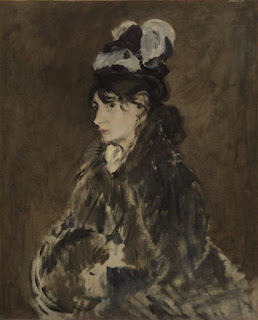 |
| Manet, Berthe Morisot with a Muff, 1869 |
By most accounts, excluding her own, Berthe Morisot was stunning. Her beauty comes across in her deep, dark eyes and delicate, chiseled features we see in Manet’s portrayals of her. She was elegant and filled with social refinement. One contemporary account described her as so full of politeness and graciousness towards others as to make acquaintances of less manners uncomfortable. Yet she broke with convention in pursuit of career in art and in the pursuit of a art style outside of tradition.
She and Manet came from similar background, he as the oldest of three boys and she as the youngest daughter in a family of three girls and one younger boy. Their parents walked in the same social circles. He spent time in the Navy, and it was awhile before his father finally agreed that he could pursue a career in art instead of law. Though it was hardly typical of women to become painters at the time, it seems that the Morisot parents were encouraging of the daughters who studied under a famous artist, Camille Corot. Berthe was the most serious, the only one to continue that career through marriage and motherhood.
 |
| Photo of Berthe Morisot, c. 1870 |
However, Manet was 9 years older and married when they met copying paintings at the Louvre copying in 1867. Each of them had already submitted paintings which had been accepted in France’s annual Salon, the yearly review of what was in judges’ views considered the best art of the time. Édouard Manet’s reputation was controversial on account of his subjects and the way he painted them. Berthe was very taken with him immediately, but of course younger French painters who were interested in breaking new artistic ground, including Monet and Renoir, also revered Manet.
 |
| Manet, Berthe Morisot with Fan, 1872 |
According to some sources, Berthe’s mother was her chaperone whenever she went to Manet’s studio, as befitted her social class. Who really knows? Manet wife was Suzanne Leenhoff, a Dutch piano teacher his father had hired years earlier to teach the Manet brothers. He married her shortly after his father died, perhaps out of obligation to protect the reputation of his father, a judge. Many sources staty that the older Manet was the father of a mysterious son she brought into the marriage, Léon Leenhoff, another favorite model of Manet’s. Léon always referred to Manet as his godfather, but may have been a half-brother. Manet’s marriage was not an easy love and he had other liaisons. However, he was always protective of his family name and loyal to this immediate family, although no children were born in the union. In his will, it was made clear the inheritance would pass from Suzanne to Léon. (Some writers believe Manet was the father. If that were true, would he be forced to cover up that the boy was born out of wedlock? No.)
The letters of Berthe Morisot were published by a grandson who edited them, perhaps leaving out things intended to remain private. In letters to her mother and sisters, she confessed strong feelings for Manet, fraught with jealousies, frustrations and the pain that it could not be more. Much of her self-doubt has to do with her frustrations as an artist, a situation most artists have at some point. Personally, I cannot stand when writers attribute female artists’ inner difficulties primarily to gender politics. Suggestions that Morisot and Manet were in competition or that he tried to hold her back are off the mark. In letters between the mother and other sisters, it’s clear that the mom feared for her youngest daughter who pined for Manet and sometimes didn’t eat. Berthe was unable to stay away from him, and he appears to have been quite attached, too. As friends, they shared an intellectual and artistic kinship. He painted many other women, repeatedly, but none with so much insight as those of Morisot.
 |
| Manet, Berthe Morisot with Violets, 1872 |
Berthe Morisot with Violets, 1872, seems for many observers to express the growing love between Manet and Morisot. To me, it is Manet’s painting of her in which Berthe seems the most forthright and the most confident. Berthe’s gaze is usually quite intense, a characteristic also found in the few photographs which exist.
However, in Berthe Morisot with a Fan, 1872, she covers her face, hinting that real intimacy with the artist was socially forbidden. Berthe Morisot with a Veil , 1874, also conveys the social blockage in the relationship. While working closely with Berthe, Manet began to loosen his brush work and get more of Impressionist swiftness to his paint. There is more spontaneity as time goes on and Manet adds many more light colors to his canvases.
Manet sometimes lightened his colors, but he rarely lightened his palette while painting Berthe Morisot. Does he see a sadness in her that does not brighten over time? Or is there a darkness that he sees and knows? Her hair was black and painting the contrast of exquisite blackness and lighter tones was his specialty. He certainly painted her with greater verve and style than many other portraits, including those of his wife and of Eva Gonzalès, a 20-year old student who came to studied under Manet. Berthe was envious of that relationship, although a portrait of Eva Gonzalès caused him much difficulty and was not successful.
 |
| Manet, Berthe Morisot in Profile, 1872 |
To a certain extent, the portraits seems to grow in their sense of intimacy as time goes on, and Berthe seems increasingly relaxed with Manet. Portait of Berthe Morisot in Profile, 1872, shows Berthe in movement with spontaneous gestures. Her expressive fingers and long hand add to a sense of elegance and she appears less serious than previous depictions. Clearly Manet found a fascinating subject.
Professionally, each artist helped and encouraged the other. On one occasion Manet complemented her on a painting and then started touching it up. She did not object and sent it to the Salon, where it was accepted. It was a painting of her mother and her pregnant sister, now in the National Gallery of Art, Washington, DC.
 |
| Manet, Berthe Morisot Reclining, 1873 |
When Degas, Pissaro and Monet wished to break out of the Salon and start their own salon des indépendentes in 1873, Manet refused to join them and opted only for the traditional road to success. This inner conservatism reflects a paradox in his character. He also advised Berthe Morisot not to rock the boat, not join in their venture, which became the first Impressionist exhibition and almost an annual event. Berthe, however, kept her own counsel and continued to exhibit with the Impressionists until 1886, when Impressionists were finally accepted and no longer needed an alternative venue. Of the 8 Impressionist exhibitions, the only one she skipped was in 1879, after giving birth to her daughter in November of the previous year.
 |
| Manet, Berthe Morisot in Mourning Hat, 1874 |
We know Berthe Morisot was highly determined to follow her chosen path and not be deterred by the man of her dreams when she disagreed. However, that doggedness often hid behind a shell of quietness and, at times, depression. Edouard Manet’s paintings of her variously capture her allure, her elegance, her intelligence and a pensiveness tinged with tragedy. He painted Berthe Morisot in a Mourning Hat in 1874, during the same year her father died. The texture is rough, the eyes are enormous and the color contrast is bold. Her color is pale and she appears emaciated. It’s an expression of the sadness she was holding deeply within her at the time.
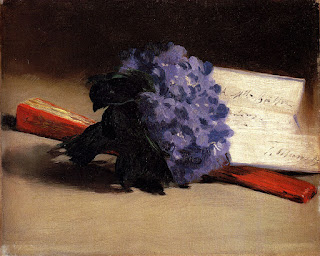 |
| Manet, Violets, 1872, was a gift to Berthe Morisot |
Manet gifted an exquisite still life of violets in 1872 to Berthe. He painted Violets with a swift, fresh and textural style, signed it and dedicated to her. Note that it includes a fan, a symbol Berthe holds in several of his earlier paintings of her. He only painted her in clothing, and she never painted him.
Berthe clearly gave Manet an outlet and a means to express his feeling for her in painting. In these portraits of her, we also see the workings of her psyche. On the other hand, he seemed to appreciate Victorine Meurent (the other favorite model who posed in Olympia, The Luncheon on the Grass, The Railway and later became a Salon painter), for the versatile expressions she could give to a painting’s message. In other words, paintings of Morisot are all about Berthe Morisot. Victorine would have had greater freedom than Berthe in some respects. Berthe Morisot and Mary Cassatt were expected to behave according to their social standing. (American Mary Cassatt and Edgar Degas were important Impressionists who had a professional relationship and bond of friendship similar to the Morisot – Manet duo. The time period was fascinating not only for how the artists related to each other, but to contemporary writers, poets, musicians and intellectuals.)
 |
| Morisot, Eugène Manet on the Island of Wight, 1875 |
 |
| Berthe Morisot, Self-Portrait, 1884 |
Édouard Manet suggested to Berthe that she marry Eugène his brother, a situation that promised they could continue indefinitely to see each other, but in the company of others. The mother’s criticisms of Édouard had been out protectiveness for the daughter, but her hesitation about Eugène was because he lacked a profession. Eventually, at age 33, Berthe and Eugène married. Four years later at age 37, she gave birth to her only child, Julie Manet. Berthe Morisot did many portraits of her daughter and her husband which suggest affection and domestic happiness.
By all accounts, Eugène Manet was kind and extremely supportive of his wife’s career and provided much administrative support for the Impressionists in general. His famous brother certainly overshadowed him in every way, but there is no evidence that he was jealous of his brother. He must have realized Berthe’s extreme fondness and probable preference for Édouard. Once they were married, the older Manet appears to have stopped painting her.
Compared to her brother-in-law Édouard’s work, Morisot’s own paintings have smaller and lighter brushstrokes, and a lighter palette. Her form is not deliberate as that of Manet. In a self-portrait of 1884, we recognize the same chiseled features and delicacy that Manet portrayed, and self-confidence. Their styles were already well developed when the met. Differences in their styles reflect the differences between their teaching: Morisot learned from Corot, the master of outdoor painting in diffused light of day, while Manet studied under Thomas Couture whose techniques are recognized in his heavier brushwork. Manet’s dark backgrounds reflect his admiration of Spanish painters Goya and Velazquez. Her forms were more diffused, silvery and more true to the goals of Impressionism.
 |
| Manet, Self-Portrait with Palette, 1878, sold at a London auction for approximately $33 million 2010 |
Though he was criticized in his early career, by the time the Impressionists were accepted and recognized, Manet was esteemed as the leader of new way of seeing and painting in a modern technique. Like his father, Manet received France’s highest honor, the prestigious Légion d’honneur before he died. Advocating for this success and protecting the honor of his family was extremely important in the end, despite his progressive political and artistic ideas. Both Édouard Manet and Berthe Morisot died fairly young, he of syphilis (like his father) in 1883, and she of pneumonia a little more than 12 years later.
 |
| Auguste Renoir, Portrait of Berthe Morisot and Julie Manet, 1894 |
|
(When the diary of Julie Manet was compiled and published many years ago, I read the book, Growing Up with the Impressionists, in which Julie Manet expresses her thoughts and feelings about her family and the important artists who were their friends. From what I remember, she seems to have had a fondness for everyone except Edouard Manet’s wife Suzanne, whom she found overbearing, perhaps reflecting her mother’s feelings.) Berthe Morisot was devastated when Manet died, and again when her husband Eugène died in 1892. Berthe and daughter Julie were extremely close. Berthe was nursing Julie who had pneumonia when she caught the bug and suddenly died in 1895. Her friends Renoir, Monet and Degas put together a large solo exhibition of her work shortly afterwards.
An orphan at age 16, Julie was left to the guardianship of painter Auguste Renoir and poet Stéphane Mallarmé. A few years later Julie married a painter, Ernest Rouart. She became an artist, as did cousins Jeannie and Paule Gobillard. Julie Manet lived until 1966, nearly 88 years, in contrast to her mother, father and uncle.
Renoir did several portraits of Julie Manet, including a painting of the Berthe Morisot with her daughter towards the end in 1894. Morisot‘s hair appears to have changed from black to gray rather quickly after the loss of Manets, both of Édouard and then her own Eugène, who she had undoubtedly loved dearly. He was kind and generous to her. When the older Manet died, his estate held a key indication of Berthe’s personal importance to him — seven of the paintings of her were found in his possession. While Manet’s wife had the financial and social benefits of marriage, he painted her less often.
 |
| Manet, Young Woman with a Pink Shoe |
|
In grad school, I took a seminar, Manet and Degas, and remember reading Manet and His Critics, as well as the novels of Émile Zola. Many books have come out since that time. Marni Kessler published an important article in The Art Bulletin about Manet’s paintings of Morisot, which I’ve not read. I’ve read The Private Lives of the Impressionists by Sue Roe and quoted her above; The Judgment of Paris by Ross King, and a biography, Rebel in a Frock Coat: Édouard Manet, by Beth Archer Brombert, each book very well documented. Impressionist Quartet, by Jeffrey Meyers, a book I’ve not read, insists they were lovers. Perhaps the most recent book to cover the Manet-Morisot relationship is Roberto Calasso’s book, La Folie Baudelaire, which has a chapter about the relationship as well as Manet’s connections to Degas.
Brombert says of Manet, “He hungered for critical and popular success but refused to yield to the taste of the day; he was the leader of a new school who dissociated himself from it as soon as it gained cohesion; he was a man of public diversion and the most private of lives.”
 |
| Morisot, Woman at Her Toilette, 1875-80 |
Manet’s greatness is in the paint and the experimental ways of presenting his subjects. At a time when painting had to compete with photography, he asserted the importance of texture and presented the ambiguities of modern life. I could not imagine Van Gogh without the influence of his rich, tactile paint and color juxtapositions as seen in the sofa of The Repose , the green of The Balcony and the lush purple Violets. Morisot’s style intersects with Manet’s at times, but in most ways she is closer to Pissarro, Renoir, Monet. She and Manet inspired each others’ artistic evolution, as did Degas and Cassatt, who excelled in the artfulness of their compositions.
Morisot’s Women at her Toilette, above, features a mirror and centers on a female figure, as in Manet ‘s very important painting, A Bar at the Folies-Bergère, but her tones are always more silvery and form is less defined. Morisot’s work is also a masterpiece, but the figure and mirror merge into the overall impression. Manet’s woman at the Folies-Bergere is an icon who reminds us of what remains when participating in the excitement of the fleeting, contemporary world. Manet is best known for painting ambiguities, while the purest Impressionist compositions of Morisot, Renoir and Monet keep the figure merely a part in the whole painted arrangement. In her modern compositions, Morisot holds her place in the path to 20th century abstraction.
Manet was the right person born at the right time to be pivotal in the changing world of art. Morisot loved him but was independent, carving out her own reputation, in her time and in our time. (Here’s a blog with a wide variety of Morisot’s paintings.) Having been soulmates unable to live together in love, Manet and Morisot respected each other until the end. Our pictures of them together remain in our imagination.
Copyright Julie Schauer 2010-2023




























Recent Comments